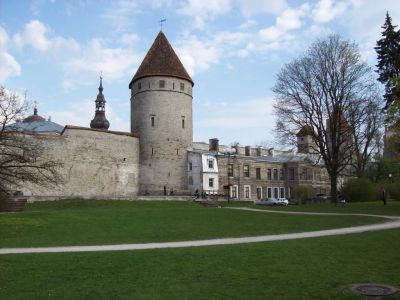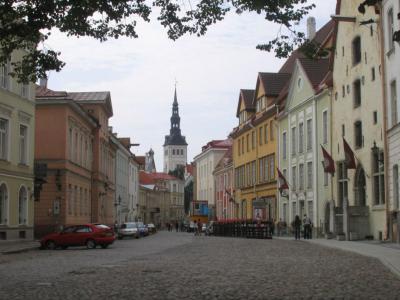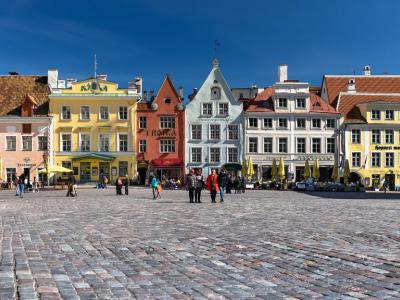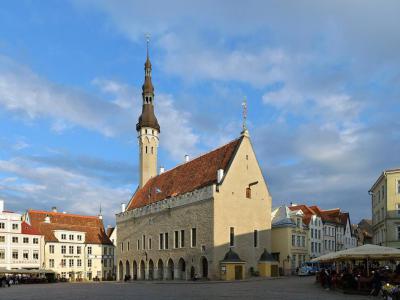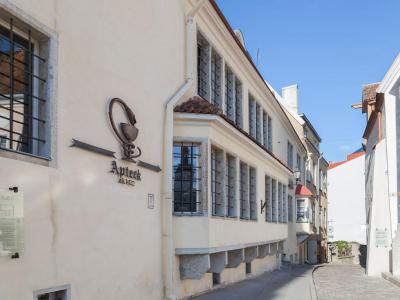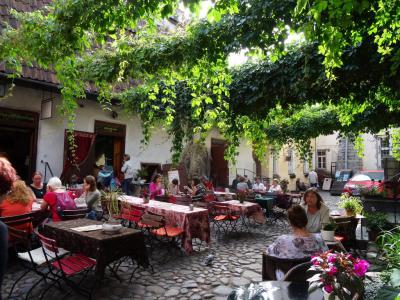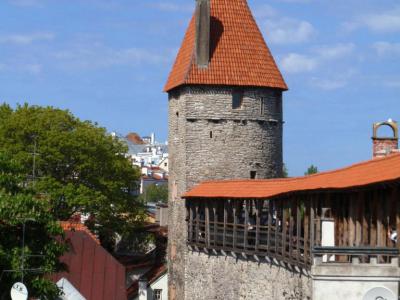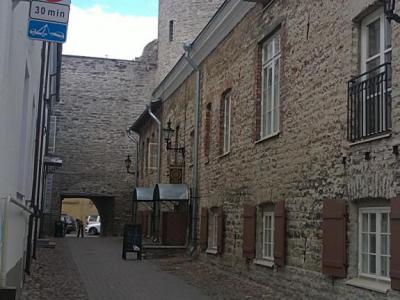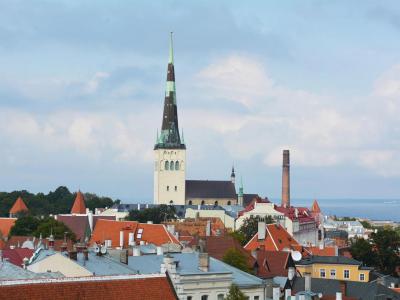Custom Walk in Tallinn, Estonia by baerenwild7897 created on 2025-01-09
Guide Location: Estonia » Tallinn
Guide Type: Custom Walk
# of Sights: 15
Tour Duration: 2 Hour(s)
Travel Distance: 2.1 Km or 1.3 Miles
Share Key: WZ4AS
Guide Type: Custom Walk
# of Sights: 15
Tour Duration: 2 Hour(s)
Travel Distance: 2.1 Km or 1.3 Miles
Share Key: WZ4AS
How It Works
Please retrieve this walk in the GPSmyCity app. Once done, the app will guide you from one tour stop to the next as if you had a personal tour guide. If you created the walk on this website or come to the page via a link, please follow the instructions below to retrieve the walk in the app.
Retrieve This Walk in App
Step 1. Download the app "GPSmyCity: Walks in 1K+ Cities" on Apple App Store or Google Play Store.
Step 2. In the GPSmyCity app, download(or launch) the guide "Tallinn Map and Walking Tours".
Step 3. Tap the menu button located at upper right corner of the "Walks" screen and select "Retrieve custom walk". Enter the share key: WZ4AS
1) Nunna, Sauna and Kuldjala Towers (Town Wall) (must see)
The Nunna, Sauna, and Kuldjala Towers are three of the remaining 26 towers that surround the Old Town of Tallinn. In the late 14th century, a massive project was started to build a fortified wall around the city to protect against invaders. By the 16th Century, the walls were raised to sixteen meters high with a thickness of 3 to 4 meters. This made it possible to defend against canon fire. During the 16th century, Tallinn was one of the most fortified cities in the entire world. The wall stretched 4 kilometers around old Tallinn.
These three towers are among the few that are still open to the general public. Visitors can come and walk through all three. In addition, there are some connection paths that are adjacent to the historic standing walls. It gives you a real sense of what the old town was like. Climbing the towers also gives you a great view of the city. You can imagine what it was like to be a guard on the towers. Admission is free.
These three towers are among the few that are still open to the general public. Visitors can come and walk through all three. In addition, there are some connection paths that are adjacent to the historic standing walls. It gives you a real sense of what the old town was like. Climbing the towers also gives you a great view of the city. You can imagine what it was like to be a guard on the towers. Admission is free.
2) Pikk Tanav (Long Street)
Long Street is aptly named. It is one of the longest streets in Tallinn and runs from Town Hall Square to near the harbor.
Long Street is full of history and beautiful medieval architecture. The buildings date from the 15th century and have been meticulously maintained. As you walk, it's easy to imagine life in Tallinn throughout its long and storied history. Gorgeous cobblestone streets such as Long Street have added to Tallinn's reputation as the best European capital to walk in.
The Great Coastal Gate & Fat Margaret Tower is located at 70 Long Street. The gate was built in the 14th century, and the tower was built in the 16th century. It now houses the Estonian Maritime Museum.
Stop at the Marzipan Gallery to taste a marzipan treat or create your own edible marzipan work of art. Hell Hunt (Gentle Wolf) Pub is the oldest pub in Tallinn and is located at 39 Long Street. Also, don't miss the Maiasmokk café, which is located at 16 Long Street and is the oldest café in Tallinn. It has been operating since 1864.
The House of the Brotherhood of the Blackheads is located at 26 Long Street. This 14th-century building is the only Renaissance-style building in Estonia. The elaborate front door is one of the most photographed scenes in Estonia.
As you walk Long Street, you'll also find a myriad of cafés, restaurants, museums, and galleries. Enjoy the walk and soak up the culture of Tallinn.
Long Street is full of history and beautiful medieval architecture. The buildings date from the 15th century and have been meticulously maintained. As you walk, it's easy to imagine life in Tallinn throughout its long and storied history. Gorgeous cobblestone streets such as Long Street have added to Tallinn's reputation as the best European capital to walk in.
The Great Coastal Gate & Fat Margaret Tower is located at 70 Long Street. The gate was built in the 14th century, and the tower was built in the 16th century. It now houses the Estonian Maritime Museum.
Stop at the Marzipan Gallery to taste a marzipan treat or create your own edible marzipan work of art. Hell Hunt (Gentle Wolf) Pub is the oldest pub in Tallinn and is located at 39 Long Street. Also, don't miss the Maiasmokk café, which is located at 16 Long Street and is the oldest café in Tallinn. It has been operating since 1864.
The House of the Brotherhood of the Blackheads is located at 26 Long Street. This 14th-century building is the only Renaissance-style building in Estonia. The elaborate front door is one of the most photographed scenes in Estonia.
As you walk Long Street, you'll also find a myriad of cafés, restaurants, museums, and galleries. Enjoy the walk and soak up the culture of Tallinn.
3) Estonian History Museum - Great Guild Hall
The Great Guild Hall is a wonderful old Gothic style structure that is located in the Old Town of Tallinn. It is not very far from Town Hall, and is just a couple of blocks south of Saint Olaf’s Church. You can find it directly across from the Holy Spirit Church.
It was built over a three year period that started in 1407. It was first used as a meeting place for Tallinn’s Merchant’s Union. During medieval times, local craft guilds controlled most aspects of business and commerce. The merchants of Tallinn banded together and became quite wealthy in their own right. Several old rooms in the building have been renovated and opened to the general public.
The hall now houses the Estonian History Museum, which brings to life over eleven thousand years of history of this part of the world. The displayed objects include archeological pieces, archived materials, ethnography, photography, glass and porcelain.
It was built over a three year period that started in 1407. It was first used as a meeting place for Tallinn’s Merchant’s Union. During medieval times, local craft guilds controlled most aspects of business and commerce. The merchants of Tallinn banded together and became quite wealthy in their own right. Several old rooms in the building have been renovated and opened to the general public.
The hall now houses the Estonian History Museum, which brings to life over eleven thousand years of history of this part of the world. The displayed objects include archeological pieces, archived materials, ethnography, photography, glass and porcelain.
4) Holy Spirit Church (Puhavaimu Kirik)
There is a lot of city history associated with the Holy Spirit Church of Tallinn. In 1531, they became the very first church to hold regular worship services in Estonian. The pastor at the time was Johann Koell, who also happens to be the person who authored the oldest surviving book known that was written in Estonian. With the assistance of Pastor Simon Wanradt from the Saint Nicholas Church, they compiled a short catechism for the people in German and Estonian. It was published circa 1535.
Pastor Balthasar Russow of the Holy Spirit Church is another famous author/clergyperson from the organization. He wrote a history book on the countries of Estonia and Livonia, as well as the war that happened between the two countries in the 16th Century.
The building dates back to the 1200s and it also served as an almshouse for the magistrate of Tallinn. From an architectural perspective, the locals call the church the museum of styles, because the sanctuary and altar have artifacts from the medieval, Baroque, and Renaissance periods. You will also want to see the woodcarvings on the balcony, as well as the arch and pews. The church bell here is also the oldest surviving in the country, dating back to 1433.
Pastor Balthasar Russow of the Holy Spirit Church is another famous author/clergyperson from the organization. He wrote a history book on the countries of Estonia and Livonia, as well as the war that happened between the two countries in the 16th Century.
The building dates back to the 1200s and it also served as an almshouse for the magistrate of Tallinn. From an architectural perspective, the locals call the church the museum of styles, because the sanctuary and altar have artifacts from the medieval, Baroque, and Renaissance periods. You will also want to see the woodcarvings on the balcony, as well as the arch and pews. The church bell here is also the oldest surviving in the country, dating back to 1433.
5) Raekoja Plats (Town Hall Square) (must see)
Town Hall Square is a fabulous location to soak up the long and storied history of Tallinn. It's in the center of the Old Town. Markets began opening on this site in the 11th century. Tallinn Town Hall is located in this square. Completed in 1404, it's the oldest Town Hall in Northern Europe.
Other historical buildings surround the square. There is the oldest pharmacy in Europe; it was established in approximately 1415. The pharmacy has a small museum with ancient medical instruments and medicines. The rest of the buildings are painted in attractive pastel colors and were built between the 15th and 17th centuries. Cobblestones throughout the square complete the old-world charm.
In the center of the square, visitors will find a circular stone with a compass rose. The L-shaped stone near the center of the square marks the site where a priest was executed. The priest killed a waitress who had served an overcooked omelet.
During the summer, the square is filled with open-air cafés. Enjoy alfresco dining and people-watching. There are regular outdoor markets held in Town Hall Square. Stalls feature souvenirs and traditional Estonian items.
You will find varied festivals and concerts throughout the year. Tallinn Old Town Days is a week-long festival that takes place at the beginning of summer. During this popular festival, visitors and locals are treated to exhibitions, theater plays, concerts, fairs, and non-stop entertainment.
In winter, the square becomes a winter wonderland with holiday decorations and a massive decorated fir tree. The Brotherhood of the Blackheads first erected a Christmas tree in the square in 1422. This is thought to be the world's first Christmas tree. Visitors can also enjoy a spirited Christmas market.
Why You Should Visit:
Town Hall Square is the oldest town square in Northern Europe and has been the center of Tallinn for eight centuries. Visit historic buildings and enjoy the old-world ambiance. There's no better place to get the feel of the town and nation than Town Hall Square.
Tips:
This square is incredibly festive over the winter holidays. Have a hot toddy, enjoy the holiday lights, shop for gifts, and admire the Christmas tree.
Other historical buildings surround the square. There is the oldest pharmacy in Europe; it was established in approximately 1415. The pharmacy has a small museum with ancient medical instruments and medicines. The rest of the buildings are painted in attractive pastel colors and were built between the 15th and 17th centuries. Cobblestones throughout the square complete the old-world charm.
In the center of the square, visitors will find a circular stone with a compass rose. The L-shaped stone near the center of the square marks the site where a priest was executed. The priest killed a waitress who had served an overcooked omelet.
During the summer, the square is filled with open-air cafés. Enjoy alfresco dining and people-watching. There are regular outdoor markets held in Town Hall Square. Stalls feature souvenirs and traditional Estonian items.
You will find varied festivals and concerts throughout the year. Tallinn Old Town Days is a week-long festival that takes place at the beginning of summer. During this popular festival, visitors and locals are treated to exhibitions, theater plays, concerts, fairs, and non-stop entertainment.
In winter, the square becomes a winter wonderland with holiday decorations and a massive decorated fir tree. The Brotherhood of the Blackheads first erected a Christmas tree in the square in 1422. This is thought to be the world's first Christmas tree. Visitors can also enjoy a spirited Christmas market.
Why You Should Visit:
Town Hall Square is the oldest town square in Northern Europe and has been the center of Tallinn for eight centuries. Visit historic buildings and enjoy the old-world ambiance. There's no better place to get the feel of the town and nation than Town Hall Square.
Tips:
This square is incredibly festive over the winter holidays. Have a hot toddy, enjoy the holiday lights, shop for gifts, and admire the Christmas tree.
6) Tallinna Raekoda (Tallinn Town Hall) (must see)
Tallinn Town Hall is the oldest and only preserved Gothic-style city hall in North Europe. In 2005, the Town Hall was awarded second prize for conservation of Architectural Heritage. Parts of the town hall date to the 13th century. The Town Hall was completed in 1404 and was the center of the town's government for almost 700 years, until 1970. Throughout the centuries, several additions, renovations, and architectural changes have been made.
Tallinn Town Hall was built with limestone. Traditional clay tiles adorn the exterior, which features a 64 meter (210 feet) tall spire that's visible from all over town. Gargoyles decorate the main facade. The Town Hall has an arcade formed with nine arcs and eight pillars. In inclement weather, merchants could gather under the shelter of the arcade. Criminals would be chained to one of the pillars so that townspeople could mock them.
The Town Hall's interior features attractive Gothic arches and works of art spanning the history of Tallinn. Benches were crafted in the 14th and 15th centuries. The largest hall in Town Hall is the Citizens Hall. It can hold up to 100 people and is often used for musical performances.
The Council Chamber features intricate wood carvings dating to 1375. Copies of 16th-century tapestries hang on interior walls. The original tapestries are on display in the Tallinn City Museum.
The Old Thomas weather vane is one of the town's most famous landmarks. The weather vane depicts a soldier who protects the city. Old Thomas was originally placed in 1530. Today, a copy stands on top of the town hall's spire, while the 1530 original is on display in the town hall's basement.
Tallinn regularly hosts concerts and receptions in this historic building. For a great view of the city, bring your camera and climb the tower.
Tallinn Town Hall was built with limestone. Traditional clay tiles adorn the exterior, which features a 64 meter (210 feet) tall spire that's visible from all over town. Gargoyles decorate the main facade. The Town Hall has an arcade formed with nine arcs and eight pillars. In inclement weather, merchants could gather under the shelter of the arcade. Criminals would be chained to one of the pillars so that townspeople could mock them.
The Town Hall's interior features attractive Gothic arches and works of art spanning the history of Tallinn. Benches were crafted in the 14th and 15th centuries. The largest hall in Town Hall is the Citizens Hall. It can hold up to 100 people and is often used for musical performances.
The Council Chamber features intricate wood carvings dating to 1375. Copies of 16th-century tapestries hang on interior walls. The original tapestries are on display in the Tallinn City Museum.
The Old Thomas weather vane is one of the town's most famous landmarks. The weather vane depicts a soldier who protects the city. Old Thomas was originally placed in 1530. Today, a copy stands on top of the town hall's spire, while the 1530 original is on display in the town hall's basement.
Tallinn regularly hosts concerts and receptions in this historic building. For a great view of the city, bring your camera and climb the tower.
7) Raeapteek (Town Hall Pharmacy)
The Town Hall Pharmacy (Raeapteek) stands as one of Europe's oldest continuously operating pharmacies, maintaining its presence within the same historic building since the early 15th century. It holds the distinction of being both Tallinn's oldest commercial enterprise and its oldest medical institution. The earliest known visual representation of the Town-Hall Pharmacy can be traced back to an oil painting by Oldekop, depicting Tallinn's Town Hall Square in 1800. Photographs capturing the building's facade date back to 1889.
The precise founding date of the pharmacy remains uncertain among historians, but the oldest available records reveal that by 1422, the Town Hall Pharmacy had already changed hands twice. Some scholars suggest that its inception could be dated to 1415.
Within a town council's ledger, an entry by a chemist named Nuclawes mentions that the pharmacy's proprietors consisted of ten esteemed individuals, with the majority holding positions as aldermen. Subsequent documents, originating after 1422, indicate that the first pharmacist, Johann Molner, took charge, and medicinal products were already being dispensed at the pharmacy during the latter part of the 15th century.
The precise founding date of the pharmacy remains uncertain among historians, but the oldest available records reveal that by 1422, the Town Hall Pharmacy had already changed hands twice. Some scholars suggest that its inception could be dated to 1415.
Within a town council's ledger, an entry by a chemist named Nuclawes mentions that the pharmacy's proprietors consisted of ten esteemed individuals, with the majority holding positions as aldermen. Subsequent documents, originating after 1422, indicate that the first pharmacist, Johann Molner, took charge, and medicinal products were already being dispensed at the pharmacy during the latter part of the 15th century.
8) Masters’ Courtyard
Masters' Courtyard in Tallinn stands out as a distinctive artisan quarter, featuring more than 10 diverse shops run by local craftsmen and artisans, along with a guesthouse and a chocolate shop.
Situated at the heart of Tallinn's historic old town, this property has a rich history dating back to 1371, having changed ownership and purposes numerous times over the past seven centuries. In 1993, the Master's Courtyard Non-profit Organization was established with the primary goal of restoring and revitalizing this property, which had suffered significant deterioration. Their vision was to transform it into an artisan hub comprising workshops, galleries, and exhibition spaces.
Today, Masters' Courtyard has gained recognition as a popular attraction for both residents and tourists alike. There are 11 distinct shops that exclusively offer products created by local artisans and artists. Some of these shops allow visitors to witness the crafting techniques and even place orders for customized items. On the courtyard's premises, you'll also find the cozy Guesthouse "Villa Hortensia," featuring six rooms equipped with kitchenettes and private bathrooms.
Additionally, there's a well-regarded chocolaterie named Chocolaterie Pierre, renowned for its handcrafted truffles, cakes, and an array of excellent coffee offerings. As you explore the various buildings within the courtyard, you'll soak in the historical ambiance, and during sunny summer evenings, you can enjoy live music in the garden.
Situated at the heart of Tallinn's historic old town, this property has a rich history dating back to 1371, having changed ownership and purposes numerous times over the past seven centuries. In 1993, the Master's Courtyard Non-profit Organization was established with the primary goal of restoring and revitalizing this property, which had suffered significant deterioration. Their vision was to transform it into an artisan hub comprising workshops, galleries, and exhibition spaces.
Today, Masters' Courtyard has gained recognition as a popular attraction for both residents and tourists alike. There are 11 distinct shops that exclusively offer products created by local artisans and artists. Some of these shops allow visitors to witness the crafting techniques and even place orders for customized items. On the courtyard's premises, you'll also find the cozy Guesthouse "Villa Hortensia," featuring six rooms equipped with kitchenettes and private bathrooms.
Additionally, there's a well-regarded chocolaterie named Chocolaterie Pierre, renowned for its handcrafted truffles, cakes, and an array of excellent coffee offerings. As you explore the various buildings within the courtyard, you'll soak in the historical ambiance, and during sunny summer evenings, you can enjoy live music in the garden.
9) St. Catherine’s Passage (Katariina Käik) (must see)
If you want to get a chance to really glimpse what life was like in the Old Town of Tallinn, you will want to visit Saint Catherine’s Passage. It is located just a short distance from the Town Hall.
The old passage connects Vene and Muurivahe Streets in town. On the northern end of the passage you will find the remnants of Saint Catherine’s Dominican Monastery Church, which is one of the oldest church in the city. In fact, the passage derives its name from the church. Many people like checking out the old tombstones that are an integral part of the sanctuary there. Many famous Estonians are buried at Saint Catherine’s cemetery.
The southern end of the passage will take you past some of the best artisan shops in Tallinn. You can watch the artists at work. It’s one of the best places to get a memento of your visit to Tallinn. The whole passage is a nice morning’s hike for the exercise alone. If you want to stop for a moment, you will want to get a cup of coffee at one of the quaint little cafes that are scattered down the passage.
The old passage connects Vene and Muurivahe Streets in town. On the northern end of the passage you will find the remnants of Saint Catherine’s Dominican Monastery Church, which is one of the oldest church in the city. In fact, the passage derives its name from the church. Many people like checking out the old tombstones that are an integral part of the sanctuary there. Many famous Estonians are buried at Saint Catherine’s cemetery.
The southern end of the passage will take you past some of the best artisan shops in Tallinn. You can watch the artists at work. It’s one of the best places to get a memento of your visit to Tallinn. The whole passage is a nice morning’s hike for the exercise alone. If you want to stop for a moment, you will want to get a cup of coffee at one of the quaint little cafes that are scattered down the passage.
10) Munkadetagune Torn (Tower behind Monks)
The Tower behind Monks is located in the Old Town and is part of the medieval defensive structures of Tallinn. Today it is located at the crossroads of Müürivahe and Munga streets, sandwiched between the Bremen Tower and the Helleman Tower. The Tower behind Monks was named due to its location behind the former Dominican monastery of Catherine.
Until the end of the 18th century, the tower housed an ammunition depot, which is why in the 17th century it was popularly called the Tower of Ignition Cords. The tower has been burned repeatedly in its history, most recently in 1994.
During 1970s-1980s, the tower was restored and a café was opened in it. After the 1994 fire, it stood empty for some years, but after a renovation was completed in 2010, the tower is again open to visitors.
Until the end of the 18th century, the tower housed an ammunition depot, which is why in the 17th century it was popularly called the Tower of Ignition Cords. The tower has been burned repeatedly in its history, most recently in 1994.
During 1970s-1980s, the tower was restored and a café was opened in it. After the 1994 fire, it stood empty for some years, but after a renovation was completed in 2010, the tower is again open to visitors.
11) Tallinn City Museum (Tallinna Linnamuuseum)
The Tallinn City Museum is a parent organization for nine different museums across the city of Tallinn, Estonia.
The main campus is housed in a building in the Old Town that dates all the way back to the 1300’s. It is a good representation of what dwellings were like in the Medieval days, which its lancet arched portal and double windows display so well. The building was owned by many famous merchants and politicians over the years.
The permanent collections on display here are designed to give the viewer a good history of the old city, beginning with the conception of the town and ending with the Independence movement for the country of Estonia in 1991.
There is a small café located in the museum and a gift shop where you can stop and have a bite after visiting the main campus.
The main campus is housed in a building in the Old Town that dates all the way back to the 1300’s. It is a good representation of what dwellings were like in the Medieval days, which its lancet arched portal and double windows display so well. The building was owned by many famous merchants and politicians over the years.
The permanent collections on display here are designed to give the viewer a good history of the old city, beginning with the conception of the town and ending with the Independence movement for the country of Estonia in 1991.
There is a small café located in the museum and a gift shop where you can stop and have a bite after visiting the main campus.
12) St. Nicholas' Orthodox Church
Saint Nicholas Church stands as a historic former church situated in Tallinn. It was originally devoted to Saint Nicholas, revered as the patron saint of fishermen and sailors. This architectural gem, dating back to the 13th century, endured partial destruction during the Soviet bombing of Tallinn in World War II. Subsequently, concerted efforts were made to restore it, and today, it serves as the home to the Niguliste Museum, a branch under the umbrella of the Art Museum of Estonia. The museum's primary focus is on ecclesiastical art spanning from the Middle Ages onwards.
The church's origins trace back to the years 1230 to 1275 when it was founded and constructed by Westphalian merchants who arrived from Gotland in the 13th century. At the time, Tallinn lacked fortifications, prompting the church to incorporate heavy bars to secure entrances, as well as openings and concealed areas for sheltering refugees. However, as Tallinn's fortifications were completed in the 14th century, with the town wall encompassing the church and settlement in 1310, Saint Nicholas Church relinquished its defensive role and transformed into a typical medieval parish church.
Between 1405 and 1420, the church underwent alterations, resulting in its present-day appearance. The central aisle was elevated to include a clerestory above the side aisles, adopting the architectural style known as a basilica. In 1515, the tower was extended in height and crowned with a late-Gothic spire. During the late 17th century, efforts were made to fortify and reinforce the tower. The original spire was replaced with a Baroque spire featuring airy galleries, which was gradually heightened over the course of several centuries. Presently, the tower stands at an impressive height of 105 meters (344.5 feet).
Remarkably, Saint Nicholas Church retained its original character amidst the iconoclastic fervor brought about by the Protestant Reformation in 1523. The church's congregation took measures to protect it by sealing its locks with molten lead, thwarting the efforts of those seeking to deface or damage it.
The church's origins trace back to the years 1230 to 1275 when it was founded and constructed by Westphalian merchants who arrived from Gotland in the 13th century. At the time, Tallinn lacked fortifications, prompting the church to incorporate heavy bars to secure entrances, as well as openings and concealed areas for sheltering refugees. However, as Tallinn's fortifications were completed in the 14th century, with the town wall encompassing the church and settlement in 1310, Saint Nicholas Church relinquished its defensive role and transformed into a typical medieval parish church.
Between 1405 and 1420, the church underwent alterations, resulting in its present-day appearance. The central aisle was elevated to include a clerestory above the side aisles, adopting the architectural style known as a basilica. In 1515, the tower was extended in height and crowned with a late-Gothic spire. During the late 17th century, efforts were made to fortify and reinforce the tower. The original spire was replaced with a Baroque spire featuring airy galleries, which was gradually heightened over the course of several centuries. Presently, the tower stands at an impressive height of 105 meters (344.5 feet).
Remarkably, Saint Nicholas Church retained its original character amidst the iconoclastic fervor brought about by the Protestant Reformation in 1523. The church's congregation took measures to protect it by sealing its locks with molten lead, thwarting the efforts of those seeking to deface or damage it.
13) Bremeni Torn (Bremen Tower)
The Bremen Tower is a four-story horseshoe-shaped tower that a defensive tower of the medieval city wall. The tower was built in the early 15th century and named after a someone who lived nearby.
The two lower floors were used as the city's prison until the 17th century. The prison is an unlit room with small air vents and a toilet with iron rings on the walls. Gunpowder was also kept the lower floor during the 18th century.
The two upper floors were defensive floors, which could be accessed from the city wall. The top floor of the tower had a open platform typical for such tower. In peacetime, the tower had a protective roof.
During the WWII, the fortification of the upper floor of the tower was destroyed and the restoration was completed in 1959. Today the tower is open to visitors.
The two lower floors were used as the city's prison until the 17th century. The prison is an unlit room with small air vents and a toilet with iron rings on the walls. Gunpowder was also kept the lower floor during the 18th century.
The two upper floors were defensive floors, which could be accessed from the city wall. The top floor of the tower had a open platform typical for such tower. In peacetime, the tower had a protective roof.
During the WWII, the fortification of the upper floor of the tower was destroyed and the restoration was completed in 1959. Today the tower is open to visitors.
14) St. Olav's Church (Oleviste Kirik) (must see)
Saint Olav’s Church is one of the oldest churches in the city of Tallinn. It was built during the 1100s, and has been the center for religious life for the Scandinavian community of the city since then. Many people that attend here can trace their heritage back to when Denmark conquered Tallinn in 1219. The church is dedicated to King Olaf II of Norway though. The oldest surviving records that refer to the church are from 1267.
There is an old legend that the builder of the church, who was also named Olaf, fell to his death from the towers of the church. It adds mystery to this place. There is a painting depicting the event in the Chapel.
Sadly, the building was damaged during the 1300s, and had to be heavily rebuilt. In the 1500s, the tower of the chapel was raised to 159 meters in the air. It has been struck by lightning many times, but the tower really has a utilitarian function: it is a seaside landmark for naval vessels. From 1549 until 1625, before the tower was burned from a lightning strike, it was the tallest structure in the known world.
During the Soviet era, the KGB used the church’s spire as a radio tower and surveillance point. Today the building now houses a Baptist church.
The tower's viewing platform offers tourists one of the best views of Tallinn, and is open to the public from April through November of each year.
There is an old legend that the builder of the church, who was also named Olaf, fell to his death from the towers of the church. It adds mystery to this place. There is a painting depicting the event in the Chapel.
Sadly, the building was damaged during the 1300s, and had to be heavily rebuilt. In the 1500s, the tower of the chapel was raised to 159 meters in the air. It has been struck by lightning many times, but the tower really has a utilitarian function: it is a seaside landmark for naval vessels. From 1549 until 1625, before the tower was burned from a lightning strike, it was the tallest structure in the known world.
During the Soviet era, the KGB used the church’s spire as a radio tower and surveillance point. Today the building now houses a Baptist church.
The tower's viewing platform offers tourists one of the best views of Tallinn, and is open to the public from April through November of each year.
15) Great Coastal Gate, Fat Margaret's Tower and Maritime Museum
If you take a trip down to the sea along Pikk Street in Tallinn, you will find two of the remaining 26 defensive towers for the city. They are the Great Coastal Gate (Suur Rannavärav) and Fat Margaret Tower (Paks Margareeta). They were designed to protect the city from seafaring invaders, as well as impress visitors that would have arrived in the city by the sea. The message they portrayed was clear: don’t even think about attacking the city from the sea.
The Great Coastal Gate is one of six remaining gates that are still intact from the old city wall system. They controlled access to the city during medieval times. This particular gate was added during the 14th century. Fat Margaret Tower was added during the 16th century, while improvements were being made to the fortifications. It was built from 1511 until 1530, and rose 25 meters above the surrounding area. The Great Coastal Gate and tower have walls that are actually a little thicker than most of the surrounding structures. They measure up to 5 meters thick. (The average thickness of the city walls is 3 meters.)
The origins of Fat Margaret's name are not well known. The best conjecture is that the tower was named for one of its larger cannons, while others hint at a cook called Margaret who once cooked for the troops that stood guard. Visitors should take a moment and climb to the top of the tower to get one of the best views in town.
Today the Estonian Maritime Museum is located in the Fat Margaret Tower. The Museum is a very popular tourist attraction in Tallinn. The institution puts on display the history of the ships of Estonia, as well as related information on what sea life was like on the Baltic. There are old tools on display here, as well as other Maritime objects. Some of the old objects here were original bone tools made before the time of Christ. So, you will not want to miss them.
The Great Coastal Gate is one of six remaining gates that are still intact from the old city wall system. They controlled access to the city during medieval times. This particular gate was added during the 14th century. Fat Margaret Tower was added during the 16th century, while improvements were being made to the fortifications. It was built from 1511 until 1530, and rose 25 meters above the surrounding area. The Great Coastal Gate and tower have walls that are actually a little thicker than most of the surrounding structures. They measure up to 5 meters thick. (The average thickness of the city walls is 3 meters.)
The origins of Fat Margaret's name are not well known. The best conjecture is that the tower was named for one of its larger cannons, while others hint at a cook called Margaret who once cooked for the troops that stood guard. Visitors should take a moment and climb to the top of the tower to get one of the best views in town.
Today the Estonian Maritime Museum is located in the Fat Margaret Tower. The Museum is a very popular tourist attraction in Tallinn. The institution puts on display the history of the ships of Estonia, as well as related information on what sea life was like on the Baltic. There are old tools on display here, as well as other Maritime objects. Some of the old objects here were original bone tools made before the time of Christ. So, you will not want to miss them.
